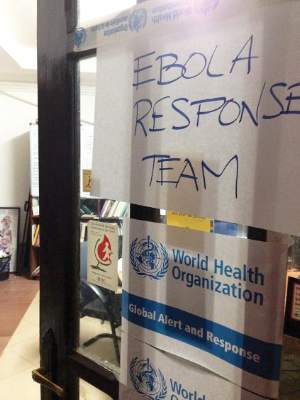The struggle to defeat Ebola virus disease continues globally, although it may not always make the headlines. To catch up on what you may have missed, here are some notable news items and journal articles published over the past few weeks that are worth a second look.
A research letter to Annals of Internal Medicine described a case study involving a patient with severe Ebola virus disease, complicated by meningoencephalitis and multiorgan failure , who was managed with supportive care alone until he recovered.
Investigators at the National Institute of Allergy and Infectious Diseases compared in vitro and in vivo approaches to the inactivation of Ebola virus specimens before removal from high-level biocontainment , to evaluate the efficacy of methods of chemical inactivation. The study establishes inactivation procedures for Ebola virus that the authors say can be safely applied to distinct specimen types and research purposes; it might also apply to other enveloped, single-strand, negative-sense RNA viruses.
Researchers from the University of Cambridge (England) evaluated the effect of presymptomatic infection on predictions of major epidemics, and found that precise estimates of the current number of infected individuals – and consequently the chance of a major outbreak in the future – cannot be inferred from data on symptomatic cases alone. They say accurate prediction is impossible without additional data from which the number of currently infected but as yet presymptomatic individuals can be deduced.
A year on from the Ebola outbreaks in West Africa, many Ebola survivors are now suffering symptoms of post-Ebola syndrome , including vision complications, joint and muscle pain, and psychiatric and neurologic problems, according to a presentation at the European Society of Clinical Microbiology and Infectious Diseases annual congress.
A study of the impact of the 2014 Ebola virus outbreak on health care attendance in the Guinean prefecture of Guéckédou found only modest decreases in nonhospital health care visits . Investigators reported a drop in visits in Guéckédou’s outpatient health care facilities during the outbreak of 4.8% and 7.4%, compared with 2013 and 2012, respectively.
TKM-130803, a small interfering RNA lipid nanoparticle product, has been developed for the treatment of Ebola virus disease (EVD) . A phase II study found that administration of TKM-130803 at an IV dose of 0.3 mg/kg per day to adult patients with severe EVD was not shown to improve survival, compared with historic controls.
A phase I study of two Ebola vaccines, Ad26.ZEBOV and MVA-BN-Filo , did not result in any vaccine-related serious adverse events in healthy volunteers. Investigators said an immune response was observed after primary immunization with Ad26.ZEBOV, while boosting by MVA-BN-Filo resulted in “sustained elevation of specific immunity.” These vaccines will be further studied in phase II and III studies.
A research brief in the Centers for Disease Control and Prevention’s Morbidity and Mortality Weekly Report revealed that a managed contact tracing program in Kambia, Sierra Leone, was effective in identifying 13 Ebola cases that might previously have been missed . The program introduced clear accountability for daily follow-up and patient status recording by contact tracers. The authors said that, based on the findings from the program, recommendations and training materials for improvements in data management and quality control to increase the effectiveness of Ebola contact tracing were subsequently developed for widespread use in Sierra Leone.
A study in Analytical Chemistry demonstrated the utilization of a recently developed cell phone–sized real-time polymerase chain reaction (PCR) device to detect Ebola virus RNA using single-step reverse transcription PCR (RT-PCR). The entire process, which consisted of reverse transcription, PCR amplification, and melting curve analysis, was conducted in less than 37 minutes, and the investigators will next attempt to form an “integrated sample-to-answer system for point-of-care infectious disease diagnostics.”
A personal protective equipment supervision protocol can reduce error rates when health care workers treating Ebola patients take off personal protective equipment , a study showed. Investigators said a video monitoring process can be an effective complement to conventional supervision methods by wardens.
The June 2015 Ebola virus disease “flare-up” in Liberia was due to a reemergence of a Liberian transmission chain originating from a persistently infected source , rather than a reintroduction from a reservoir or a neighboring country with active transmission, according to a report in Science Advances. The authors said the findings highlight the risk of EVD flare-ups even after an outbreak is declared over.
On Twitter @richpizzi





